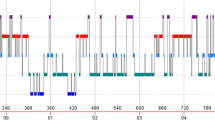Abstract
Objective
To investigate the effect of combining acupuncture and auricular point sticking on heart rate variability (HRV) in patients with post-stroke depression (PSD).
Methods
A total of 80 cases with PSD were randomized into a treatment group and a control group. The control group was intervened by oral administration of paroxetine hydrochloride, whereas the treatment group received acupuncture plus auricular point sticking base on the same oral administration. The Hamilton depression rating scale (HAMD) and HRV were measured before and after treatment in both groups.
Results
The individual and global scores of HAMD significantly dropped after 8 weeks of treatment in both groups (all P<0.05). In the treatment group, anxiety/somatization factor, sleep disturbance, hopelessness factor, cognition factor and global score were significantly different from those in the control group (all P<0.05). The 24 h standard deviation of all normal-to-normal R-R interval (SDNN), standard deviation of 5-minute average of normal R-R intervals (SDANN), root mean square of successive differences (RMSSD), percent of differences between adjacent normal R-R intervals >50 ms (PNN50) and high frequency (HF) were increased while low frequency (LF) and LF/HF decreased significantly after 8 weeks of treatment in both groups (P<0.05). All items in the treatment group were significantly different from those in the control group (all P<0.05).
Conclusion
Combining acupuncture and auricular point sticking can enhance the conventional medical treatment for HRV in patients with PSD.
摘要
目的
观察针刺加耳穴贴压治疗对脑卒中后抑郁患者心率变异性(HRV)的影响。
方法
将80名脑卒中后抑郁患者随机分为治疗组和对照组, 每组40例。对照组口服盐酸帕罗西汀片, 治疗组在口服相同药物基础上加用针刺和耳穴贴压治疗。比较治疗前后两组患者汉密尔顿抑郁量表(HAMD)评分及HRV变化。
结果
治疗8星期后, 两组HAMD各因子评分及总分均较本组治疗前下降(均P<0.05); 治疗组焦虑/躯体化因子、睡眠障碍因子、绝望感因子、认知因子及总分分值均低于对照组(均P<0.05)。治疗8星期后, 两组24 h内窦性心律R-R间期标准差(SDNN)、每5 min窦性心率的R-R间期平均值标准差(SDANN)、24 h内窦性心律相邻R-R间期差值的均方根(RMSSD)、24 h内相邻窦性心率R-R间期差大于50 ms的个数占百分比(PNN50)及高频成分(HF)均较治疗前增加, 低频成分(LF)及低频高频比(LF/HF)均较治疗前降低, 组内差异均有统计学意义(均P<0.05); 治疗组各项指标与对照组均有统计学差异(均P<0.05)。
结论
在常规药物治疗基础上加用针刺和耳穴贴压可增强常规药物治疗对脑卒中后抑郁患者HRV的改善作用。
Similar content being viewed by others
References
Reurological Rehabilitation Group of Neurology Branch of Chinese Medical Association, Cerebrovascular Disease Group of Neurology Branch of Chinese Medical Association, Ministry of Health Stroke Screening and Prevention Engineering Committee Office, Zhang T. Chinese stroke rehabilitation guidelines (2011 full version). Zhongguo Kangfu Lilun Yu Shijian, 2012, 18(4): 301–318.
Hackett ML, Yapa C, Parag V, Anderson CS. Frequency of depression after stroke: a systematic review of observational studies. Stroke, 2005, 36(6): 1330–1340.
Robinson RG, Spalletta G, Jorge RE, Bassi A, Colivicchi F, Ripa A, Caltagirone C. Decreased heart rate variability is associated with poststroke depression. Am J Geriatr Psychiatry, 2008, 16(11): 867–873.
Rao ML. China Guideline for Cerebrovascular Disease Prevention and Treatment: A Trial Version. Beijing: People's Medical Publishing House, 2007: 21–67.
American Psychological Association. Diagnostic and Statistical Manual of Mental Disorders (Fourth Edition, Text Revised) (DSM-IV-TR). Washington, DC: 2000.
Psychosis Branch of Chinese Medical Association. The Chinese Classification and the Diagnose Criterion of Mental Disorder. 3rd Edition. Jinan: Shandong Technology Press, 2001: 87–88.
Fruehwald S, Gatterbauer E, Rehak P, Baumhackl U. Early fluoxetine treatment of post-stroke depression: a threemonth double-blind placebo-controlled study with an openlabel long-term follow up. J Neurol, 2003, 250(3): 347–351.
Yin HL. A Correlative Study on the Symptoms, Neuroendocrine and Autonomic Nerve Function of Depression and Anxiety Disorder. Guangzhou: Southern Medical University, 2011.
Burton CL, Hultsch DF, Strauss E, Hunter MA. Intraindividual variability in physical and emotional functioning: comparison of adults with traumatic brain injuries and healthy adults. Clin Neuropsychol, 2002, 16(3): 264–279.
Niu YL, Liu CM, Wang XD, Wang LN, Liu Y, Feng XD. Effect of acupuncture combined with moxibustion on HRV in patients with post-stroke depression. Zhongguo Kangfu Lilun Yu Shijian, 2015, 21(2): 196–198.
Linde K, Streng A, Jürgens S, Hoppe A, Brinkhaus B, Witt C, Wagenpfeil S, Pfaffenrath V, Hammes MG, Weidenhammer W, Willich SN, Melchart D. Acupuncture for patients with migraine: a randomized controlled trial. JAMA, 2005, 293(17): 2118–2125.
Gao XY. Auriculotherapy and the Ear-vagus-visceral Reflex. Beijing: Doctor Thesis of China Academy of Chinese Medical Science, 2005.
Bauer A, Malik M, Schmidt G, Barthel P, Bonnemeier H, Cygankiewicz I, Guzik P, Lombardi F, Müller A, Oto A, Schneider R, Watanabe M, Wichterle D, Zareba W. Heart rate turbulence: standards of measurement, physiological interpretation, and clinical use: International Society for Holter and Noninvasive Electrophysiology Consensus. J Am Coll Cardiol, 2008, 52(17): 1353–1565.
Wolf P, Koepp M. Reflex epilepsies. Handb Clin Neurol, 2012, 107: 257–276.
Zhang MJ, Wei MW, Li J. Effect of acupuncture at point Neiguan (PC 6) on variability of heart rate. Zhongguo Zhen Jiu, 2003, 23(3): 169–170.
Acknowledgments
This work was supported by Wang Jing-jing’s Inheritance Studio of National Famous Traditional Chinese Medicine Experts ( 王净净全国名老中医药专家传承工作室); Graduate Student Research Innovation Project of Hunan Province ( 湖南省研究生科研创新项目, No. CX2016B354); Open Fund for National Key Discipline of Diagnostics of Traditional Chinese Medicine, (中医诊断学国家重点学科开放基金资助项目, No. 2015ZYZD27).
Author information
Authors and Affiliations
Corresponding author
Rights and permissions
About this article
Cite this article
Zhang, L., Zhong, Y., Quan, Sl. et al. Effect of combining acupuncture and auricular point sticking on heart rate variability in patients with post-stroke depression. J. Acupunct. Tuina. Sci. 15, 392–397 (2017). https://doi.org/10.1007/s11726-017-1034-7
Received:
Accepted:
Published:
Issue Date:
DOI: https://doi.org/10.1007/s11726-017-1034-7




